Abstract
The analysis of the relationship between radon and seismicity was previously carried out in the seismic zone of Vrancea (Romania), positioning the measuring stations on tectonic faults. This article analyzed the evolution of radon under conditions of deep and surface seismicity and the presence of mud volcanoes, as well as fires caused by gasses emanating from the ground. The monitoring area was extended to the Black Sea and the area of the Făgăraș-Câmpulung fault, where a special radon detection system was established and proposed for patenting. The case study was the impact of the earthquakes in Turkey (7.8 R and 7.5 R on 6 February 2023) on the seismically active areas in Romania in terms of gas emissions (radon, CO2). The main analysis methods for radon (we also included CO2) were applied to integrated time series and the use of anomaly detection algorithms. Data analysis showed that the effects of global warming led to variations in seasonal gas emissions compared to previous years. This made it difficult to analyze the data and correlate it with seismicity. Several of the cases presented require more in-depth analysis to determine the cause of the unusually high radon levels. The primary purpose of establishing the monitoring network is to use the gas emissions as seismic precursors, but the measurements are affected by the conditions under which the monitoring is conducted. In some cases, we are dealing with the effects of pollution, and in other cases, more extensive studies are required. One solution we plan to use is to expand the measurement points to locate the source of the anomalies and use weather data to determine the impact of global warming on the measurements. The main conclusions related to the development of a radon monitoring network and, in general, to the emission of gasses in earthquake-prone areas relate to the importance of the choice of equipment, monitoring location, and installation method.
1. Introduction
This article presents the evolution of implementations and results from the development process of a radon monitoring network as part of a multidisciplinary approach by the National Institute of Earth Physics in Romania [1,2,3]. The main goal is to create an automated seismic forecasting system (OEF—Operational Earthquake Forecasting) based on real-time data such as radon, CO2, air ionization, telluric currents, magnetic field, ULF-VLF radio waves, and seismic information. Realizations of this type exist each following a certain parameter for detection [4,5,6,7,8,9], but each solution refers to a certain area that is monitored. The radon level depends on the tectonic stress that induces a deformation of the rocks [10,11,12,13], which in turn depends on the environmental factors. For this reason, the use of a trigger threshold per level for anomaly detection is not possible, but a real-time OEF (Operational Earthquake Forecasting) can be implemented such as in [2]. In [3,5], an application for the Vrancea zone (the curvature area of the Carpathian Mountains) is presented; in [4] is the forecasting is for Japan; Reference [6] used a general monitoring of electromagnetic emissions (EM) (we tried something similar, but the results are not convincing for Vrancea [10]); and Reference [7] prospected for operational forecasting of earthquakes in Europe using seismic information, but the catalogs are not homogeneous and the seismicity patterns are too different for different areas. The authors of the article [8] specify the difference between forecast and prediction, emphasizing the difficulties of using it in general the ‘time-dependent seismic hazards to help communities prepare for potentially destructive earthquakes. The main problem of using seismic catalogs is that they reflect more the detection capacity of the respective networks. The most recent example for Romania is Oltenia, Gorj area, where more than 2000 surface earthquakes occurred recently and which was reclassified as a seismic risk area after 200 years (https://data.mendeley.com/datasets/28kv3gsgcz/2, accessed on 27 September 2022). The large number of earthquakes is due to the increase in detection capacity as a result of monitoring with a larger number of seismic stations installed in that area. Even if the statistical methods are correct, they are applied on insufficient data, especially when they refer to natural phenomena. Radon monitoring also expanded as a result of the development of monitoring equipment, which depended on technological development in general. Our efforts to integrate real-time radon data were described in [3]. At the current stage, all multidisciplinary information is accessible in real time from a database that has an interface for viewing at gebs.infp.ro (API interface—JSON format, sample data at https://data.mendeley.com/datasets/28kv3gsgcz/2, accessed on 27 September 2022). The biggest challenges were the integration of data coming from equipment with different hardware and software interface options, the creation of metadata, the implementation of the database, its management, and access to information. Radon concentration as seismic precursor is mentioned in OEF [9] along the fluctuations of the ‘groundwater level, electromagnetic variations near and above the Earth’s surface, thermal anomalies, abnormal animal behavior, seismicity models’ and with the possibility of generating false alarms.
This paper analyzed the relationship between radon and CO2 emissions, seismicity, and meteorological conditions, along with several case studies, such as the relationship between recent seismic events in Turkey (7.8 R) and seismicity in Romania, or radon exceedance in some situations. A description of the network (stations, equipment, their positioning, activity periods, measurement results) and metadata can be found in Section 2. A special case is the Râmnicu Vâlcea station, built for radon monitoring (patent application [14]). The analytical methods used are described in [2,3] and are applied to several case studies. The first one refers to the use of radon and CO2 in the correlation of seismic events in Turkey (7.8 R) and those in the Râmnicu Sărat area (Romania), followed by the analysis of an earthquake sequence from Vrancea with a magnitude of 4.2 R through the prism of gas emissions, a case of pollution at the Black Sea caught during the attempt to monitor the Shabla area, and the exceeding of the value of 300 Bq/mc (the limit set by Council Directive 2013/59/EURATOM) in several situations. We also performed an analysis of the dependence of radon and CO2 emissions on meteorological factors, seismic energy, and seismicity of Vrancea, represented by parameters a-b of the Gutenberg–Richter law [15,16]. In these cases, we applied correlation and averaging functions to sliding time windows applied to radon time series. The results are comparable to the function-based methods in the LabVIEW programming environment library. One aspect analyzed is the correlation of radon emissions with the characteristics of the Vrancea area, which is characterized by both intermediate earthquakes (unlikely to cause direct gas emissions) and crustal earthquakes. Finally, the analysis of the data from 2016 shows that climate changes cause radon emissions to increase together with temperature.
2. The New Radon and CO2 Monitoring Network
2.1. The Updated Structure of the Monitoring Network
The first development of a radon detection device for Vrancea was carried out by IFIN HH and installed at the Plostina station (INFOSOC 2006 project—complex system for monitoring and processing precursors of major seismic events by modern techniques, Figure 1). The high radon values in Figure 1 were not confirmed by the measurements performed with a device of the RADON SCOUT type, which was installed in 2017 at the same location and is still working (Table 1).
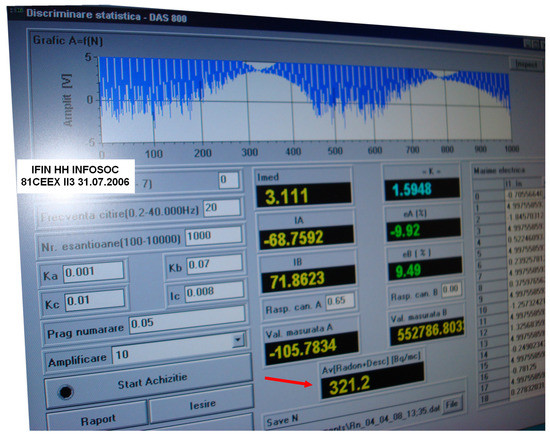
Figure 1.
The software for the first development of an experimental radon detection in a seismic zone was created by IFIN HH, 2006.

Table 1.
Radon network, locations, equipment, and period of operation.
Concerns about the relationship between radon emission and seismicity have expanded to include a multidisciplinary monitoring network that currently includes gas emission as a precursor parameter [2,3]. Figure 2 (the green markers indicate radon and CO2, the yellow ones mean radon devices only) and Table 1 show the evolution of the radon monitoring network, to which CO2 has been added as a seismic precursor [17,18], but also as a parameter for the analysis of greenhouse gas impacts and climate change.
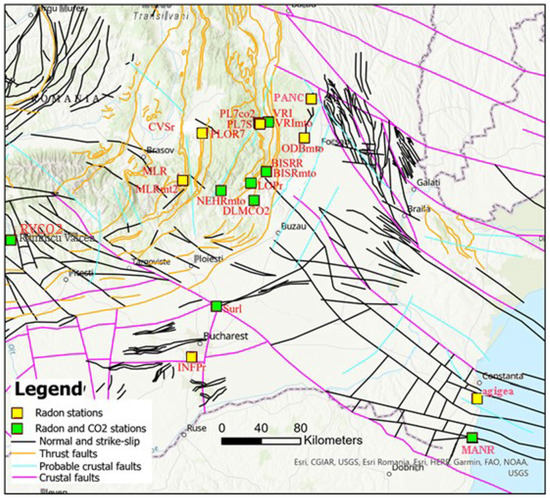
Figure 2.
Map of radon and CO2 monitoring locations; faults are according to Project CEEX NR.647/2005 CEEX 647 (C. Dinu, V. Răileanu et al.).
The Carpathian Mountains formed through a process spanning the Triassic to Tertiary periods, involving the transformation of continental units and the closure of Alpine Thetys and its branches. These continental units consist of the Tisza–Dacia and Alps–Carpathian–Pannonian (ALCAPA) blocks, located internally, while externally, there is the European/Scythian/Moesian continental foreland. The arcuate shape of the Carpathians is mirrored by this external foreland [19]. During the Quaternary period, the significant amount of shortening, reaching up to 5 km, was laterally distributed through transcurrent movements along the major faults that delineate the southeastern Carpathians, specifically the Trotus and Intramoesian faults. Notably, there are observable patterns (south to Trotus Fault) of active faulting in close proximity to the boundary between the Moesian platform and the North Dobrogean orogen. These patterns can be attributed to strain partitioning, which occurs due to the differentiation of stress between mechanically weak and strong lithospheric regions, as explained by Matenco et al. in 2007 [20]. As a result of this complex tectonic evolution, the Vrancea zone is characterized by seismic activity from both crustal and intermediate earthquakes, with moderately strong to strong earthquakes occurring more frequently in the intermediate sector. Intermediate seismicity is concentrated in the bend of the Carpathian arc in the Vrancea region. In the intermediate sector, a compressive regime dominates, leading to reverse faulting and vertical extension [21]. Conversely, crustal earthquakes are influenced by an extensional regime characterized by normal and strike-slip faulting [22]. As it can be seen in Figure 2, we plotted on the map the main faults resulting from the complex tectonic process described above, as well as the distribution of measurement stations. The radon measurement stations are located both near the faults and above the two seismic zones in Vrancea (Intermediate Vrancea and Crustal Vrancea).
Monitoring stations are located near the faults (Figure 2) because that is where gas emissions are most evident [23,24,25,26].
Radon variations are not sufficient to implement a seismic forecasting method. There are other types of devices installed in all monitoring stations. Table 2 shows some of them (CO2 and weather stations) that contribute to the analysis of seismic precursors besides radon. An example of the analysis of the relationship between radon and CO2 can be found in the article [27].

Table 2.
Equipment that is part of the multidisciplinary monitoring of seismic areas.
The description of the data provided by the equipment that measures the radon level (Table 3 and Table 4) is included in a general database (https://data.mendeley.com/datasets/28kv3gsgcz/2, accessed on 27 September 2022).

Table 3.
Radon equipment used in Bisoca station (BISRAERd), produced by ALGADE (discontinued).

Table 4.
Radon equipment produced by SARAD.
In addition to the location of the monitoring station and the type of equipment used, its installation is also important. The only monitoring station built specifically for this purpose is located in Râmnicu Vâlcea (Electrovalcea SRL site) (Figure 3, RMGVdd in Table 1 and Table 5).
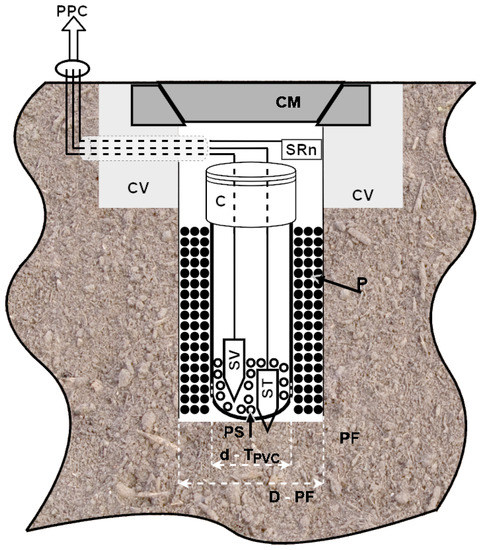
Figure 3.
Installation of radon and acceleration sensors in a 40 m deep borehole [14].

Table 5.
Synthesized results of radon monitoring, the 2SD reference parameter, and its dependence on temperature.
The description of Figure 3 according to the patent application “OSIM a 2020 00500 10 August 2020” [14] and the article [28] is as follows:
| PF | — | Borehole, 40 m deep; |
| D | — | Diameter between 300 and 500 mm; |
| SV | — | Vibration sensor (triaxial accelerometer); |
| PS | — | Glass balls for fixing SV; |
| ST | — | Temperature sensor; |
| TPVC | — | PVC tube; |
| C | — | PVC cover; |
| P | — | 10–30 mm gravel that ensures the diffusion of radon from the bottom of the well to the SRn radon sensor; |
| SRn | — | Radon sensor mounted in the CV visiting space made of reinforced concrete; |
| CV | — | Visiting space; |
| CM | — | Metal cover; |
| PPC | — | Precursor parameters of earthquakes. |
More explanations can be found in [28]: ‘According to Figure 3, the vibration transducer SV is mounted between glass beads PS in a drilled well PF 40 m deep and D-PF diameter Φ 350 mm. For the SV protection and of the ST temperature sensor, they are mounted in a PVC protection tube with a diameter of d- TPVC Φ 120 mm. The space between the TPVC and the diameter of the drilled well D-PF is filled with gravel P (1–3 cm), which ensures the diffusion of radon to the radon detector SRn mounted in the manhole CV made of reinforced concrete and covered with a metal cover CM. The PVC TPVC protection tube is covered with a C cover also made of PVC’.
This station was considered a reference because there were no seismic events in the area. Starting with 8 February 2023, over 2000 surface earthquakes occurred at an approximate distance of 80 km in Oltenia, Gorj area (example in Table 7), with the maximum magnitude being 5.7 R. However, no radon level anomalies were recorded in RMGVdd.
2.2. Results of the Radon Monitoring
Table 5 shows the radon monitoring results, including the standard deviation (SD) of the reference parameters and air temperature. The equipment used to determine the radon content also includes sensors for temperature, humidity, and air pressure, i.e., the parameters on which the emission of gasses depends [29,30].
In most cases, the radon anomaly is defined as the positive deviation that exceeds the average radon level by more than two standard deviations, 2SD [31,32,33]. The temperature T (C) in Table 5 was measured by the equipment that determines the level of radon. We observed that radon level was over 300 Bq/mc (the limit established by Council Directive 2013/59/EURATOM of 5 December 2013) in MLRdd, SURLdd, and MNGdd. In the first case, the measurements were made in a tunnel in the mountain, which explains the high values. The limit values determined in Surlari (SURLdd) can be explained by the effect of the forest in which the monitoring location is located [34]. In the last case (a case study will follow), Mangalia MNGdd, we recorded very high values and variations of radon, CO2, and CO. There was a proportional relationship between the radon level and the temperature in the case of the stations BISRAERd, PLRdd2, and RMGVdd (Table 5). In the other stations, this relationship was not preserved, which means that the temperature was not a determining factor in the evolution of the radon level, which depends a lot on the local conditions in which the equipment is installed [34,35]. The fluctuations that occurred were caused by the fact that radon can be brought by the wind from other areas compared to the case of the BISRAERd, PLRdd2, and RMGVdd stations where the spaces where the measurements were made were more isolated.
3. Analysis Methods and Case Studies
The analysis methods used are described in [2,3]. They have been verified with respect to Vrancea seismicity and are currently used for climate change impact analysis. Essentially, the time series representing the gas emissions (radon, CO2) are integrated after the extraction of the mean, then an algorithm for the detection of STA/LTA (Short-Term Averages/Long-Term Averages) of Allen type ([36,37,38]) or 2SD (two standard deviations) is applied [33,39]. Signal integration is performed with a function from the LabVIEW library that performs numerical integration using the trapezoidal rule. The Allen detection algorithm is used in earthquake early warning systems but could also be applied to other time series. The standard deviation is a common method for determining radon anomalies. The average radon concentration is the reference value. If radon exceeds the values of +/− 2 SD, an event is present. These methods are limited because they depend on the time intervals chosen (daily, seasonal, and annual).
3.1. Case Study: Sequence of Surface Earthquakes, Râmnicu Sărat Area
An example of a case in which these methods are applied is the sequence of surface earthquakes in the area of Râmnicu Sărat (city in Romania), which could have been induced by the seismic events in Turkey (6 February 2023, 7.8 R and 7.5 R, Figure 4) that overlapped (Table 6). This is possible is the earthquakes are above 7 R: ‘Earthquakes, particularly large ones, can trigger other earthquakes in more distant locations though a process known as dynamic stress transfer/triggering’ but should be checked in our case. (https://www.usgs.gov/faqs/can-large-earthquake-trigger-earthquakes-distant-locations-or-other-faults, accessed on 10 June 2023).
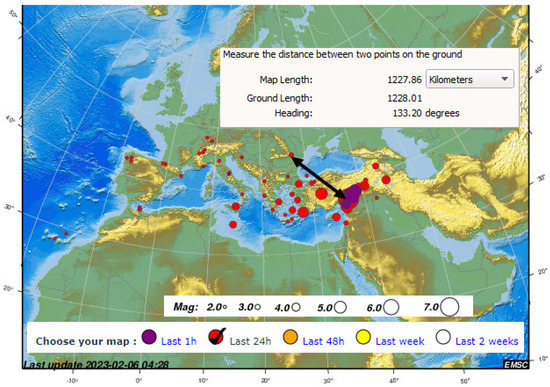
Figure 4.
Superposition of the earthquake swarm in Romania with the seismic events in Turkey (6 February 2023, 7.8 R and 7.5 R), picture EMSC/CSEM, http://www.emsc-csem.org/, accessed on 6 February 2023.

Table 6.
Overlap of earthquakes in Turkey and Romania (http://www.infp.ro/, accessed on 21 May 2023).
Table 6 shows that the first seismic event in Turkey (6 February 2023, 01:17:36, 7.8 R) was shortly followed by an earthquake in Romania (6 February 2023, 01:26:20, 4.6 R) at a distance of 1228 km.
Figure 5 (top right) shows the distribution of earthquakes in the period 1 January 2023–12 March 2023, and the A–N section is described in F. Hauser et al., ‘VRANCEA99-. The crustal structure beneath the Southeastern Carpathians and the Moesian platform from a seismic refraction profile in Romania’ (Figure 6).
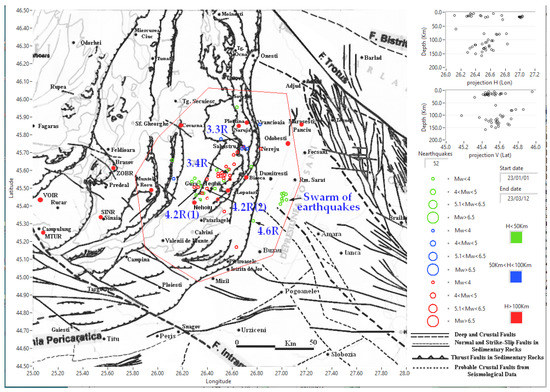
Figure 5.
Vrancea seismicity and the correlation of epicenters with geological faults, 1 January 2023–12 March 2023; swarm of Râmnicu Sărat earthquakes (green circles) and 4.2 R earthquakes sequence; faults are according Project CEEX NR.647/2005 CEEX 647 (C. Dinu, V. Răileanu et al.).
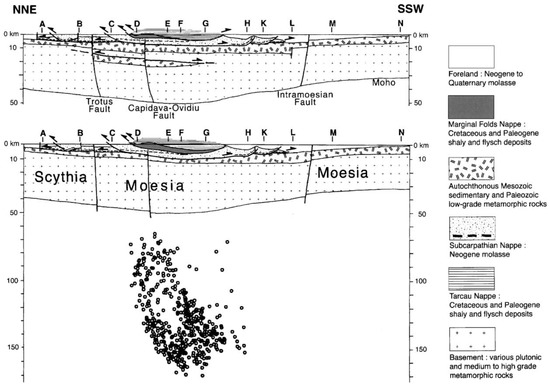
Figure 6.
Pre-1999 geological section along the main NNE–SSW VRANCEA99 [40].
The closest radon and CO2 monitoring stations are in Dalma (DLMdd), Bisoca (BISRAERd), and Lopatari (LOPRdd) (Table 1). Applying the mentioned methods, we obtained the evolution of radon and CO2 as in Figure 7. Only for LOPRdd did we use the 2SD detection method [33], while for the others, we used STA/LTA. It was observed that radon and CO2 had similar variations, and those in Bisoca and Dalma were similar, unlike those in Lopatari. Moreover, the detections (marked with red dots) can be associated with groups of earthquakes, and the seismic pause that preceded the sequence of earthquakes was longer (seismic quiescence of 7 days [17]). In conclusion, the first seismic event in Turkey could only have triggered what is happening anyway, with the Râmnicu Sărat area being known for such behavior.
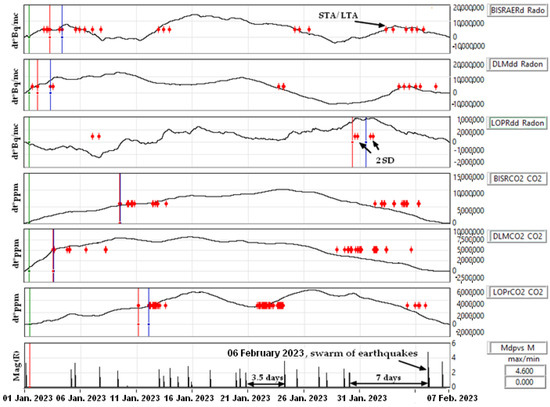
Figure 7.
The evolution of radon and CO2 preceding the earthquake sequence near Râmnicu Sărat, detections marked with red dots.
3.2. Case Study: Earthquakes Sequence 4.2 R
Another case study is the earthquakes sequence from 11 March 202 to 12 March 2023 in which we had two earthquakes of 4.2 R accompanied by two others of 3.3 R and 3.4 R. These are presented in Figure 5 and Figure 8, and Table 7.
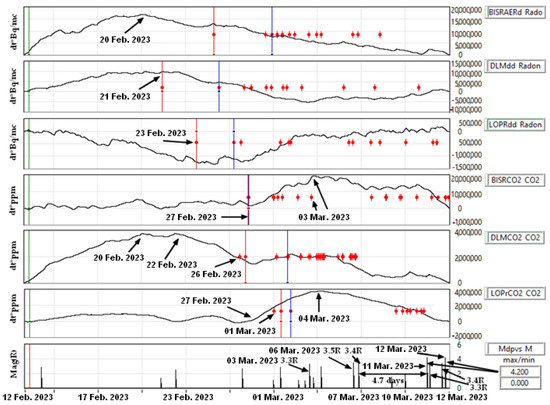
Figure 8.
The evolution of radon and CO2 for the 4.2 R earthquakes sequence, detections marked with red dots.

Table 7.
Seismic sequence in the Vrancea area, maximum M 4.2 R, swarm of earthquakes in Oltenia, Gorj.
The 4.2 R earthquakes were located in the Gura Teghii seismic zone, and all epicenters were on faults (Figure 5). The detections starting with 20 February 2023 in Figure 8 (red points) were of the STA/LTA type and were applied to the integrated time series. There was a similarity in time variations between radon in BISRAERd, DLMdd, and carbon dioxide in DLMCO2 (maximum during 20 February 2023 followed by a decrease). Moreover, the evolution of radon in LOPRdd was similar to CO2 in BISRCO2 and LOPrCO2.
We can say that the method described in [1,2] is also verified in this case, and what matters is the grouping of earthquakes in a short period of time (1–2 days), even if their magnitude is not high.
3.3. Case Study: Pollution and Gas Emissions
The next analyzed case refers more to environmental pollution than to a relationship between gas emission and seismicity. In Table 5, the last two stations (named Agigea, Agigea locality, and MNGdd, Mangalia locality) refer to the results of radon monitoring at the Black Sea (their positioning is in Table 1). A large difference was observed in the level of radon caused by MNGdd, while in Agigea, the radon values were normal (Table 5). However, the time periods in which the determinations were made should be noted. Those in Mangalia were recent and may have been affected by the development of the city and the port. Not only the high values attracted our attention, but also the way in which the gas emission varied in this location. In Figure 9, there are very large variations of radon that did not repeat at intervals of one day and did not depend on temperature, atmospheric pressure, precipitation, or wind (EFORmt2 is a meteorological station, Table 2). Besides these, the presence of CO and the way it varied indicated a pollution that can be caused by the activity of the port, a hospital, or the nearby water treatment plant. The radon measurements at the Black Sea were described in [41], wherein the emission of gases (radon, CO2, methane, hydrogen sulfide) was specified and analyzed, but not in the coastal region of Romania.
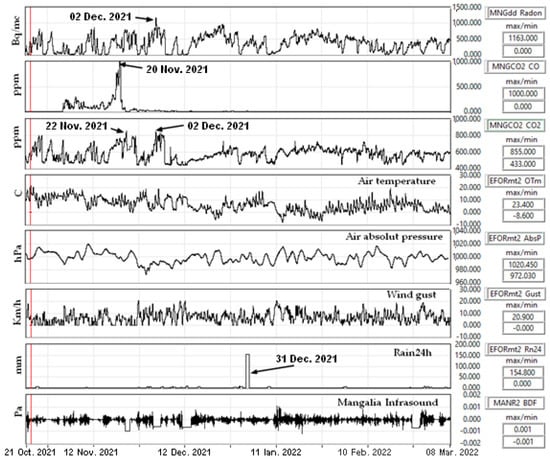
Figure 9.
The case of Mangalia: the evolution of radon, CO2, and atmospheric conditions.
3.4. Case Study: Radon Exceed Limit 300 Bq/mc
Another case to which our attention is drawn in Table 5 is the fact that the radon level in the Surlari station (Figure 10, SURLdd) exceeded the limit of 300 Bq/mc established in Council Directive 2013/59/EURATOM. The building where the radon detector was located is made of bricks and is located in a forest (Figure 10b).
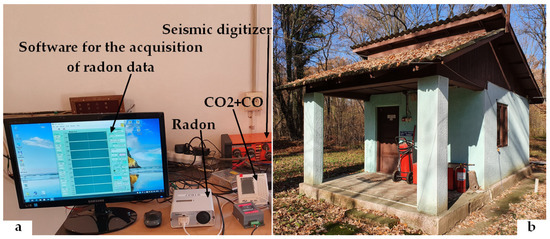
Figure 10.
Surlari monitoring station: (a) radon, CO2, and CO equipment; (b) the location is in a forest.
The evolution of radon and CO2, maximum and minimum values, along with temperature and humidity in this location are presented in Figure 11.
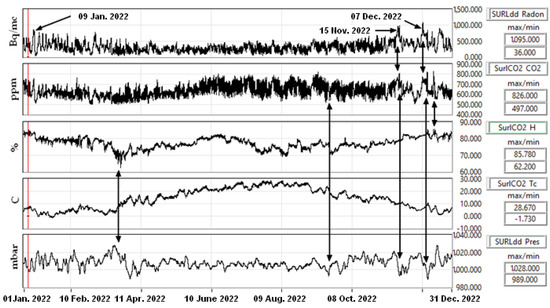
Figure 11.
Radon, CO2, temperature, and air pressure in Surlari station (SURLdd).
It was observed that there was a relationship between the radon level and temperatures in the sense that during the winter, the radon emission increased. The Surlari location is close to the Intramoesica fault and is characterized by surface seismicity. It was observed that there was a relationship between the radon level, temperature, humidity, and atmospheric pressure [42,43,44]. Seasonal variation indicated an increase in radon emission in winter (lower temperatures), while CO2 increased in summer (higher temperatures). The daily variations of radon indicated a maximum around 10 UTC hour and a minimum approximately at 19 UTC hour. After filtering with a median filter (LabVIEW library) on the time series from Figure 11 for reducing the daily variations and spikes, we applied a cross-correlation function (LabVIEW library) and obtained the average values from Table 8 (example in Figure 12 and Figure 13). Regardless of the chosen method, it is important that it is used under the same conditions in all the analyzed cases. So, Table 8 is relative to this method over the entire time period (one year) and allows for comparative data analysis. The possible high values of radon and CO2 levels were the relation between gas emission and vegetation [34]. The operation of the equipment was checked under normal conditions, and the results were satisfactory. The sensors in Figure 10 were moved because the room where the measurements were taken was not the best location for determining the source of radon or CO2.

Table 8.
Cross-correlation coefficients.
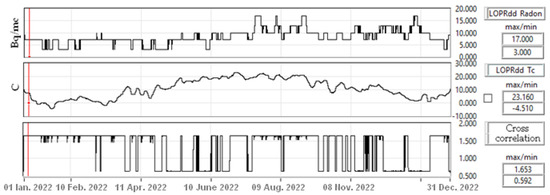
Figure 12.
Cross-correlation between radon and humidity in Lopatari station, 2022, 1 h intervals.
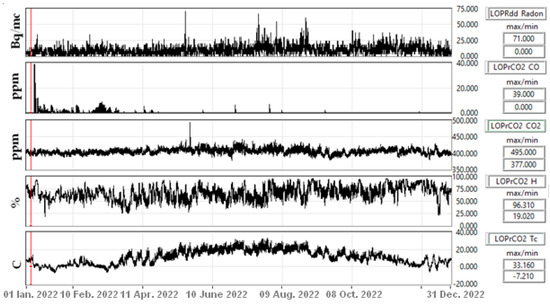
Figure 13.
Gas emissions in Lopatari, 2022.
3.5. Case Study: Influence of Meteorological Parameters on Gas Emissions
Another issue is the influence of meteorological parameters on gas emissions, which is presented in many articles [42,45,46]. For our case study, we chose the same time period (year 2022) as in Figure 11 to follow the evolution of radon and CO2 as a function of temperature, humidity, and atmospheric pressure. Table 8 shows the correlation between radon and CO2, humidity, temperature, and atmospheric pressure (the complementary parameters measured by the same instruments) for the year 2022.
We notice in Figure 11 that there were correlations over short time intervals. We redid the comparative analysis for the year 2022 but at on a sliding time window of one hour and calculated the average of the obtained coefficients (Table 9). If a positive correlation prevailed, then we would have higher positive final values. However, we could also have an inverse correlation (the sizes are inversely proportional) that would lead to mostly negative results. The way in which the method is applied is represented in Figure 12. So, the values in Table 9 and Table 10 are relative and allow for an assessment of the dependence of radon on atmospheric factors.

Table 9.
Cross-correlation for time windows of 1 h.

Table 10.
Vrancea seismicity for earthquakes greater than 4.5 R, 2016–2022.
3.6. Case Study: CO Can Be a Seismic Precursor
A special case in Lopatari is CO as a result of fire gasses produced by live fires (Figure 13). The time series used in Table 8 and Table 9 are shown in Figure 13 and Figure 14. In general, temperature and humidity were inversely proportional (an example in Figure 13 for the Panciu station, PANCdd). This, as well as the dependence of radon on atmospheric factors, depends on the type of installation of the equipment. It can be seen from Table 8 that the dependence of radon on temperature in Lopatari (LOPRdd) was very low, since the measurements were performed with the same equipment (Radon Scout Plus), which was located in a partially air-conditioned room space. For this reason, the relationship between temperature and humidity deviated from normal conditions (Figure 13) (for example, in Panciu, Figure 14). A similar situation existed in Bisoca (BISRAERd).
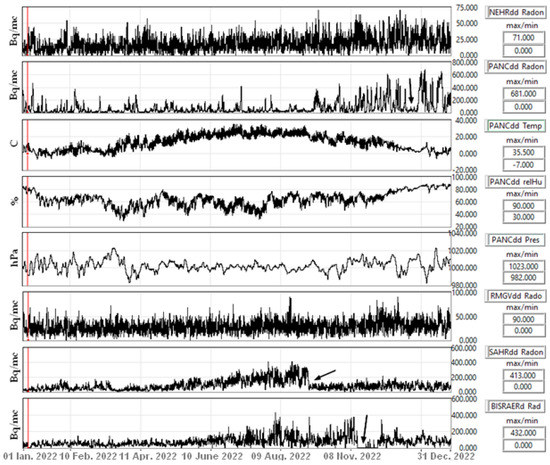
Figure 14.
Dependence of radon on atmospheric factors, 2022.
Laboratory measurements of radon highlighted the same direct positive relationship between radon emission and temperature [10]. This is valid if the radon emission and its measurement are done in the same place. In our locations, the rooms where the equipment are placed are not hermetically sealed, and radon can come from nearby areas as a result of air currents. From Figure 11, Figure 13 and Figure 14, a similar evolution of radon can be observed in LOPRdd, RMGVdd, SAHRdd, and BISRAERd (higher values in summer) and for SURLdd, NEHRdd, and PANCdd (higher values in winter). These results are preserved if we analyze the evolution of radon over several years (Figure 15).
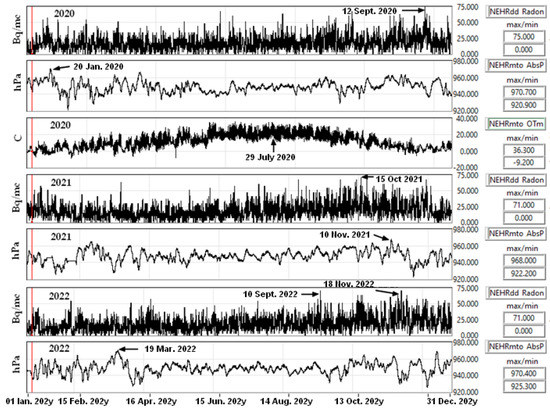
Figure 15.
The annual evolution of radon in Nehoiu (NEHRdd) and environmental factors.
3.7. Case Study: Radon Emission and Seismicity
The next case analyzed concerns the relationship between radon emission and seismicity. We already analyzed the Râmnicu Sărat case (Table 6, Figure 7) and the 11 March 2023–12 March 2023 earthquake series (Table 7, Figure 8). We next chose a longer period between 2016 and 2022 and earthquakes larger than 4.5 R in the Vrancea area (Table 10). The preparation zone PZone was determined by the relationship of Dobrovolsky [47] as a function of magnitude. The relation was experimentally verified with Mw. The monitoring station should be located in this area to assess a relationship between radon and earthquakes. Different formulas for the relationship between earthquake magnitude and preparation distance by different authors were mentioned by Nevinsky in [41]. In general, this condition is satisfied in Table 10, since we chose a threshold value of 4.5 R for the magnitude. The relationship between the accumulated seismic energy, the parameters a-b from the Gutenberg–Richter law [15,16], the seismicity, and the number of earthquakes generated in a 7-day interval is shown in Figure 16.
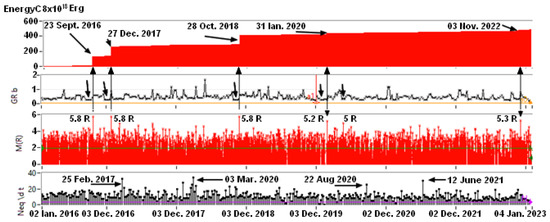
Figure 16.
Cumulative seismic energy, the Gutenberg–Richter parameter ‘b’, seismicity, and the number of earthquakes produced in a 7-day interval.
From Figure 16 and Figure 17, it can be seen that a decrease over a period of more than 18 days of the parameter ‘b’ from the Gutenberg–Richter law (GR_b) was followed by earthquakes with a magnitude greater than 5 R (observation valid for the Vrancea area). The radon and temperature time series in Figure 17 were averaged to mitigate daily variations. We note that the maximum values of radon levels were between August and November and did not correlate with the number of earthquakes produced at 7-day intervals (Neq/dt graph). We applied a correlation function between parameter ‘b’ from the Gutenberg–Richter law (GR_b) and radon for the period 2016–2022 for the case where the depth of the hypocenter was greater than 20 km or less. Depth is important because the source of radon should be on the surface because its half-life is 3.82 days. The results are shown in Figure 18 and Table 11.
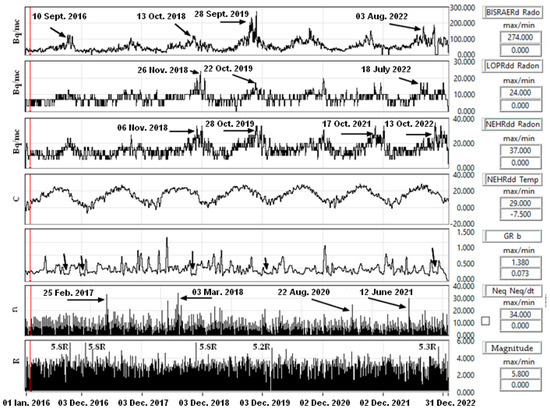
Figure 17.
Evolution of radon level, temperature, and seismicity in Vrancea; time windows of 7 days, 2016–2022.
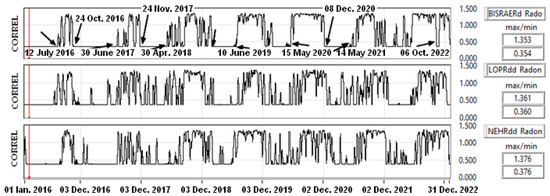
Figure 18.
CORREL between GR b (Gutenberg–Richter law) and radon BISRAERs, LOPRdd, and NEHERdd.

Table 11.
Correlation factor between ‘b’ parameter and radon in BISRAERd, LOPRdd, and NEHERdd, 2016–2022; time windows of 7 days.
Correlation of ‘b’ parameters between crustal and deep seismicity for Vrancea using a sliding time window of 7 days is shown in Figure 19, where mean = 0.8767 and SD = 0.4508.
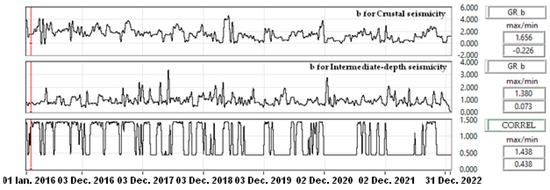
Figure 19.
Correlation between b from the Gutenberg–Richter law for Vrancea crustal and deep seismicity.
3.8. Case Study: Radon Variations and Climate Change
Integrating the time series from Figure 17, we obtained the radon variations from Figure 20. We observed a continuous increase in radon level along with the temperature, which we can interpret as an effect of climate change.
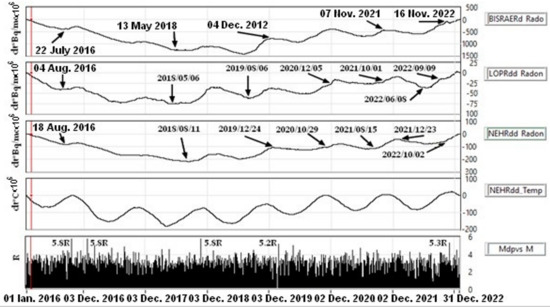
Figure 20.
Annual variations of radon integrated and Vrancea seismicity, 2016–2022.
4. Conclusions
From the data presented, it is not possible to establish an exact relationship between the anomalies of radon emissions and seismicity, but evaluations can be made that can be completed with forecasts. Radon level recording depends on environmental factors, location, and installation area. For this reason, the results presented in different articles for different domains may be different. An example has already been mentioned regarding the evolution of radon in LOPRdd, RMGVdd, SAHRdd, and BISRAERd (higher values in summer) and for SURLdd, NEHRdd, and PANCdd (higher values in winter) (Figure 11, Figure 13 and Figure 14). We chose monitoring positions near geological faults, but it is not enough because they may not be active for gas emission. The investigation area was Vrancea (the curvature area of the Carpathian Mountains), which is characterized by deep earthquakes (Table 10). Table 11 shows that the mean value of the correlation factors determined in a 7-day sliding window, and the corresponding SDs were close in value for surface and depth earthquakes (correlation between ‘b’ parameters in Figure 19). These determinations (Table 11) depend a lot on the calculation method and the way the time series were filtered. We first applied a median filter (LabVIEW library) on the time series from Figure 11 for reducing the daily variations and spikes; next, we used a cross-correlation function (LabVIEW library) and obtained the average values and SD. For this reason, it is important to use the same method for all determinations and the analysis of the results to be comparative.
There will always be a degree of uncertainty because the emission of radon and gases in general depends on many factors. For this reason, a validation with other parameters is necessary. Another direction of development of the multidisciplinary monitoring network and its use is the expansion of measurement points and the introduction of the function of locating sources of disturbances. Climate change affects gas emissions, and their effect needs to be mitigated through data analysis, but they are useful for a new direction of research. In each location, we have weather stations that we will use for corrections and also to analyze the effects of global warming along with CO2.
In presenting the link between the radon level and seismicity, we used the parameters a–b from the Gutenberg–Richter law (Figure 16). We observed that a decrease over a period longer than 18 days of the parameter ‘b’ from the Gutenberg–Richter law (GR_b) is followed by earthquakes with a magnitude greater than 5 R (Figure 16 and Figure 17) for the Vrancea area. For this reason, there is no general method, and an implementation of an OEF must take into account the particularities of the monitoring area. In our case, the Vrancea area is unique in Europe due to its geological structure and its deep earthquakes.
One of the most important issues in monitoring geophysical parameters is the location where the equipment is installed. In the case of gas emissions, we tried to position our devices on faults or as close to them as possible. In the areas we selected, we made tomographic resistivity and seismic profiles, as shown in Figure 21 and Figure 22 for the station Bisoca (BISRAERd in Table 1 and Table 2) located on the Casin–Bisoca fault.
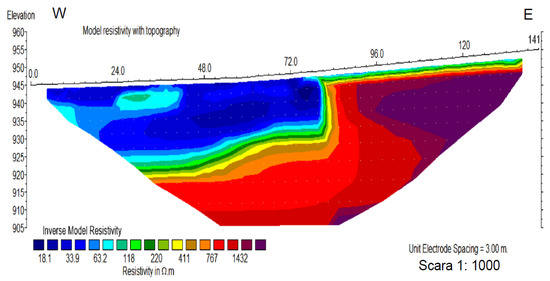
Figure 21.
Electrical resistivity tomography section in Bisoca station BISRAERd (project of the Romanian National Authority for Scientific Research, Programe STAR, project 84/2013, made by Getotec Consulting SRL).
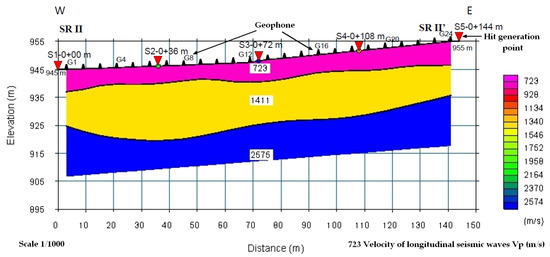
Figure 22.
SEISMIC REFRACTION SECTION S.R. II-II in Bisoca station BISRAERd (project of the Romanian National Authority for Scientific Research, Programe STAR, project 84/2013, made by Getotec Consulting SRL).
It is very difficult to determine how radon reaches the surface or where and how it is concentrated. There may be cavities where it concentrates and is released by the increase in outside temperature and the expansion of cracks in the soil or for other reasons. At this site, we made radon measurements in a 2 m deep pit next to a magnetometer. The variations were very small, although there were earthquakes, but their epicenters were in a different area. You should have a large number of instruments installed in the boreholes. This is not possible, because it requires large financial resources, and it is difficult to drill in mountainous areas, where you must also have the necessary infrastructure. For this reason, the radon detection device was installed in a building connected by a PVC hose to a 2 m deep pit. In this case, it is more difficult to locate the radon source because it can be introduced by air currents. For this reason, we used the wind speed and direction determined by the weather stations installed in all stations. In some cases, this is possible. An example of this can be found in the article [48] that refers to a natural ‘drill’: the volcano Etna. To understand how the radon anomalies were produced, they made a model of radon transport to the surface (source areas and gas carrier velocity). We will address these aspects in a fundamental research project. At this stage, the only data needed for OEF implementation are those that can be predictably correlated, without the need for details on the origin of gas emissions. The only specialized setup for measuring radon and CO2 is in Figure 3.
One method we plan to use to determine the optimal locations for gas monitoring devices is to deploy a device consisting of at least 16 individual elements, which include a radon and a CO2 detector, each connected via WiFi, to be distributed in a grid over the target area. The method is similar to that used in resistivity tomography based on electrodes embedded in the ground. We intend to use the resistivity and seismic tomography we have for several sites to correlate with gas emissions. In addition, the monitoring network will soon be expanded to include new instruments (radon, CO2) that will be installed in 2–3 m deep wells adjacent to the existing seismic sensors.
An improvement in data analysis is achieved by the introduction of artificial intelligence (AI). In general, there are no patterns (at least) for the Vrancea area, but it is worth trying.
Author Contributions
Conceptualization, V.E.T.; methodology, V.E.T. and I.-A.M.; software, V.E.T.; validation, A.M. (Alexandru Marmureanu), N.-S.B., and C.I.; formal analysis, I.-A.M., A.M. (Andrei Mihai), and I.L.; investigation, V.E.T. and I.-A.M.; writing—original draft preparation, V.E.T. and N.-S.B.; correspondent, V.E.T.; supervision, N.-S.B. and I.L. All authors have read and agreed to the published version of the manuscript.
Funding
This paper was funded by MCI grant number PN23360201 (SOL4RISC).
Institutional Review Board Statement
Not applicable.
Informed Consent Statement
Not applicable.
Data Availability Statement
An example of the data is archived at https://data.mendeley.com/datasets/28kv3gsgcz, published: 27 September 2022 |Version 2| https://doi.org/10.17632/28kv3gsgcz.2 (accessed on 21 May 2023).
Acknowledgments
This paper was carried out within Nucleu Program SOL4RISC, supported by MCI, project no PN23360201; AFROS Project PN-III-P4-ID-PCE-2020-1361, supported by UEFISCDI; and the National Recovery and Resilience Plan, ‘PNRR-III-C9-2022-I5 Establishment and operationalization of Competence Centers’ competition, ‘Competence Center for Climate Change Digital Twin for Earth forecasts and societal redressment (DTEClimate) and The Research Center for Climate Change due to natural Disasters and extreme weather Events-REACTIVE’ projects, contract no. 760008/30.12.2022, code 7/16.11.2022.
Conflicts of Interest
The authors declare no conflict of interest.
References
- Toader, V.E.; Moldovan, I.A.; Marmureanu, A.; Nastase, E. Monitoring of radon and air ionization in a seismic area. Rom. Rep. Phys. 2017, 69, 842013. [Google Scholar]
- Toader, V.-E.; Nicolae, V.; Moldovan, I.-A.; Ionescu, C.; Marmureanu, A. Monitoring of Gas Emissions in Light of an OEF Application. Atmosphere 2020, 12, 26. [Google Scholar] [CrossRef]
- Toader, V.-E.; Mihai, A.; Moldovan, I.-A.; Ionescu, C.; Marmureanu, A.; Lingvay, I. Implementation of a Radon Monitoring Network in a Seismic Area. Atmosphere 2021, 12, 1041. [Google Scholar] [CrossRef]
- Omi, T.; Ogata, Y.; Shiomi, K.; Enescu, B.; Sawazaki, K.; Aihara, K. Implementation of a Real-Time System for Automatic Aftershock Forecasting in Japan. Seismol. Res. Lett. 2019, 90, 242–250. [Google Scholar] [CrossRef]
- Toader, E.; Moldovan, I.A.; Mihai, A. Forecast Earthquake Using Acoustic Emission. In International Multidisciplinary Scientific GeoConference Surveying Geology and Mining Ecology Management; SGEM: Varna, Bulgaria, 2019; Volume 19, pp. 803–811. [Google Scholar] [CrossRef]
- Kachakhidze-Murphy, N.; Kachakhidze, M.; Biagi, P.F. Earthquake Forecasting Possible Methodology. GESJ Phys. 2016, 1, 102–111. [Google Scholar]
- Zechar, J.D.; Marzocchi, W.; Wiemer, S. Operational earthquake forecasting in Europe: Progress, despite challenges. Bull. Earthq. Eng. 2016, 14, 2459–2469. [Google Scholar] [CrossRef]
- Jordan, T.H.; Chen, Y.-T.T.; Gasparini, P.; Madariaga, R.; Main, I.; Marzocchi, W.; Papadopoulos, G.; Yamaoka, K.; Zschau, J. Operational earthquake forecasting: State of knowledge and guidelines for utilization. Ann. Geophys. 2011, 54, 319–391. [Google Scholar] [CrossRef]
- Jordan, T.H.; Marzocchi, W.; Michael, A.J.; Gerstenberger, M.C. Operational earthquake forecasting can enhance earthquake preparedness. Seismol. Res. Lett. 2014, 85, 955–959. [Google Scholar] [CrossRef]
- Tuccimei, P.; Mollo, S.; Soligo, M.; Scarlato, P.; Castelluccio, M. Real-time setup to measure radon emission during rock deformation: Implications for geochemical surveillance. Geosci. Instrum. Methods Data Syst. 2015, 4, 111–119. [Google Scholar] [CrossRef]
- Bauer, S.J.; Gardner, P.; Lee, H. Real Time Degassing of Rock during Deformation. In Proceedings of the 50th US Rock Mechanics/Geomechanics Symposium, Houston, TX, USA, 26–29 June 2016; pp. 1–7. [Google Scholar]
- Ambrosino, F.; Thinová, L.; Briestenský, M.; Giudicepietro, F.; Roca, V.; Sabbarese, C. Analysis of geophysical and meteorological parameters influencing 222Rn activity concentration in Mladeč caves (Czech Republic) and in soils of Phlegrean Fields caldera (Italy). Appl. Radiat Isot. 2020, 160, 109140. [Google Scholar] [CrossRef]
- Morales-Simfors, N.; Wyss, R.A.; Bundschuh, J. Recent progress in radon-based monitoring as seismic and volcanic precursor: A critical review. Crit. Rev. Environ. Sci. Technol. 2020, 50, 979–1012. [Google Scholar] [CrossRef]
- Ciogescu, O.; Lingvay, D.; Șchiopu, M.; Lingvay, I.; Toader, V.E.; Ionescu, C.; Marmureanu, A. Complex system for prediction, warning of seismic movements and fire prevention following damage to gas installations caused by major earthquakes. In BOPI Patent Application 02/2021; a 2020 00500/10-08-2020; OSIM: Singapore, 2021; Volume 2, p. 35. [Google Scholar]
- Nava, F.A.; Márquez-Ramírez, V.H.; Zúñiga, F.R.; Lomnitz, C. Gutenberg–Richter b-value determination and large-magnitudes sampling. Nat. Hazards 2017, 87, 1–11. [Google Scholar] [CrossRef]
- Toader, V.E.; Popescu, I.M.; Moldovan, I.A.; Constantin, I. Vrancea seismicity analysis based on cumulative seismic energy. UPB Sci. Bull. Ser. A Appl. Math Phys. 2015, 77, 297–308. [Google Scholar]
- D’Incecco, S.; Petraki, E.; Priniotakis, G.; Papoutsidakis, M.; Yannakopoulos, P.; Nikolopoulos, D. CO2 and Radon Emissions as Precursors of Seismic Activity. Earth Syst. Environ. 2021, 5, 655–666. [Google Scholar] [CrossRef]
- Zafrir, H.; Barbosa, S.; Levintal, E.; Weisbrod, N.; Ben Horin, Y.; Zalevsky, Z. The Impact of Atmospheric and Tectonic Constraints on Radon-222 and Carbon Dioxide Flow in Geological Porous Media—A Dozen-Year Research Summary. Front. Earth Sci. 2020, 8, 559298. [Google Scholar] [CrossRef]
- Schmid, S.M.; Bernoulli, D.; Fügenschuh, B.; Matenco, L.; Schefer, S.; Schuster, R.; Tischler, M.; Ustaszewski, K. The Alpine-Carpathian-Dinaridic orogenic system: Correlation and evolution of tectonic units. Swiss J. Geosci. 2008, 101, 139–183. [Google Scholar] [CrossRef]
- Matenco, L.; Bertotti, G.; Leever, K.; Cloetingh SA, P.L.; Schmid, S.M.; Tărăpoancă, M.; Dinu, C. Large-scale deformation in a locked collisional boundary: Interplay between subsidence and uplift, intraplate stress, and inherited lithospheric structure in the late stage of the SE Carpathians evolution. Tectonics 2007, 26, TC4011. [Google Scholar] [CrossRef]
- Radulian, M.; Popescu, E.; Bala, A.; Utale, A. Catalog of fault plane solutions for the earthquakes occurred on the Romanian territory. Rom Rep. Phys. 2002, 47, 663–686. Available online: http://scholar.google.com/scholar?hl=en&btnG=Search&q=intitle:CATALOG+OF+FAULT+PLANE+SOLUTIONS+FOR+THE+EARTHQUAKES+OCCURRED+ON+THE+ROMANIAN+TERRITORY#0 (accessed on 21 May 2023).
- Radulian, M.; Mândrescu, N.; Panza, G.F.; Popescu, E.; Utale, A. Characterization of Seismogenic Zones of Romania. Pure Appl. Geophys. 2000, 157, 57–77. [Google Scholar] [CrossRef]
- Chen, Z.; Li, Y.; Liu, Z.; Wang, J.; Zhou, X.; Du, J. Radon emission from soil gases in the active fault zones in the Capital of China and its environmental effects. Sci. Rep. 2018, 8, 16772. [Google Scholar] [CrossRef]
- Khan, M.A.; Khattak, N.U.; Hanif, M. Radon emission along faults: A case study from district Karak, Sub-Himalayas, Pakistan. J. Radioanal. Nucl. Chem. 2022, 331, 1995–2003. [Google Scholar] [CrossRef]
- Ioannides, K.; Papachristodoulou, C.; Stamoulis, K.; Karamanis, D.; Pavlides, S.; Chatzipetros, A.; Karakala, E. Soil gas radon: A tool for exploring active fault zones. Appl. Radiat Isot. 2003, 59, 205–213. [Google Scholar] [CrossRef]
- Xuan, P.T.; Duong, N.A.; Van Chinh, V.; Dang, P.T.; Qua, N.X.; Van Pho, N. Soil Gas Radon Measurement for Identifying Active Faults in Thua Thien Hue (Vietnam). J. Geosci. Environ. Prot. 2020, 8, 44–64. [Google Scholar] [CrossRef]
- Shahrokhi, A.; Burghele, B.D.; Fábián, F.; Kovács, T. New study on the correlation between carbon dioxide concentration in the environment and radon monitor devices. J. Environ. Radioact. 2015, 150, 57–61. [Google Scholar] [CrossRef] [PubMed]
- Toader, V.E.; Ciogescu, O.; Mihai, A.; Lngvay, D.; Borș, A.; Lingvay, I. Complex system for earthquake prediction and protection of gas installations. EEA Electroteh Electron Autom. 2020, 68, 100–106. [Google Scholar] [CrossRef]
- Haquin, G.; Zafrir, H.; Ilzycer, D.; Weisbrod, N. Effect of atmospheric temperature on underground radon: A laboratory experiment. J. Environ. Radioact. 2022, 253–254, 106992. [Google Scholar] [CrossRef] [PubMed]
- Kulali, F.; Akkurt, I.; Özgür, N. The Effect of Meteorological Parameters on Radon Concentration in Soil Gas. Acta Phys. Pol. A 2017, 132, 999–1001. [Google Scholar] [CrossRef]
- Ivanova, K.; Stojanovska, Z.; Djunakova, D.; Djounova, J. Analysis of the spatial distribution of the indoor radon concentration in school’s buildings in Plovdiv province, Bulgaria. Build Environ. 2021, 204, 108122. [Google Scholar] [CrossRef]
- Bem, H.; Janiak, S.; Przybył, B. Survey of indoor radon (Rn-222) entry and concentrations in different types of building in Kalisz, Poland. J. Radioanal. Nucl. Chem. 2020, 326, 1299–1306. [Google Scholar] [CrossRef]
- Al-Hilal, M.; Abdul-Wahed, M.K. Soil gas radon measurements for investigating the actual status of seismic quiescence along the bounding fault of the Ghab pull-apart basin in western Syria. Geofis. Int. 2018, 57, 177–187. [Google Scholar] [CrossRef]
- Megonigal, J.P.; Brewer, P.E.; Knee, K.L. Radon as a natural tracer of gas transport through trees. New Phytol. 2020, 225, 1470–1475. [Google Scholar] [CrossRef] [PubMed]
- Jayaratne, E.R.; Ling, X.; Morawska, L. Role of Vegetation in Enhancing Radon Concentration and Ion Production in the Atmosphere. Environ. Sci. Technol. 2011, 45, 6350–6355. [Google Scholar] [CrossRef] [PubMed]
- Vrex, A. Automatic Earthquake Recognition and Timing from Single Traces. Bull. Seismol. Soc. Am. 1978, 68, 1521–1532. [Google Scholar]
- Allen, R. Automatic phase pickers: Their present use and future prospects. Bull. Seismol. Soc. Am. Geosci. 1982, 72, S225–S242. Available online: https://pubs.geoscienceworld.org/ssa/bssa/article-abstract/72/6B/S225/102172/Automatic-phase-pickers-Their-present-use-and?redirectedFrom=fulltext (accessed on 28 April 2020). [CrossRef]
- Jones, J.P.; van der Baan, M. Adaptive STA–LTA with Outlier Statistics. Bull. Seismol. Soc. Am. 2015, 105, 1606–1618. [Google Scholar] [CrossRef]
- Gregori, A.; Zmazek, B.; Deroski, S.; Torkar, D.; Vaupoti, J. Radon as an Earthquake Precursor—Methods for Detecting Anomalies. In Earthquake Research and Analysis—Statistical Studies, Observations and Planning; InTech: Milton, Australia, 2012; pp. 179–196. [Google Scholar] [CrossRef]
- Hauser, F.; Raileanu, V.; Fielitz, W.; Bala, A.; Prodehl, C.; Polonic, G.; Schulze, A. VRANCEA99-The crustal structure beneath the Southeastern Carpathians and the Moesian platform from a seismic refraction profile in Romania. Tectonophysics 2001, 340, 233–256. [Google Scholar] [CrossRef]
- Nevinsky, I.; Tsvetkova, T.; Dogru, M.; Aksoy, E.; Inceoz, M.; Baykara, O.; Kulahci, F.; Melikadze, G.; Akkurt, I.; Kulali, F.; et al. Results of the simultaneous measurements of radon around the Black Sea for seismological applications. J. Environ. Radioact. 2018, 192, 48–66. [Google Scholar] [CrossRef]
- Ptiček Siročić, A.; Kovač, S.; Stanko, D.; Pejak, I. Dependence of concentration of radon on environmental parameters. Environ. Eng. 2021, 8, 17–25. [Google Scholar] [CrossRef]
- Xie, D.; Liao, M.; Kearfott, K.J. Influence of environmental factors on indoor radon concentration levels in the basement and ground floor of a building—A case study. Radiat Meas. 2015, 82, 52–58. [Google Scholar] [CrossRef]
- Taşköprü, C.; İçhedef, M.; Saç, M.M. Diurnal, monthly, and seasonal variations of indoor radon concentrations concerning meteorological parameters. Environ. Monit. Assess. 2023, 195, 25. [Google Scholar] [CrossRef]
- Aquilina, N.; Fenech, S. The Influence of Meteorological Parameters on Indoor and Outdoor Radon Concentrations: A Preliminary Case Study. J. Environ. Pollut. Control. 2019, 2, 107. [Google Scholar]
- Sundal, A.V.; Valen, V.; Soldal, O.; Strand, T. The influence of meteorological parameters on soil radon levels in permeable glacial sediments. Sci. Total Environ. 2008, 389, 418–428. [Google Scholar] [CrossRef] [PubMed]
- Dobrovolsky, I.P.; Zubkov, S.I.; Miachkin, V.I. Estimation of the size of earthquake preparation zones. Pure Appl. Geophys. PAGEOPH 1979, 117, 1025–1044. [Google Scholar] [CrossRef]
- Neri, M.; Ferrera, E.; Giammanco, S.; Currenti, G.; Cirrincione, R.; Patanè, G.; Zanon, V. Soil radon measurements as a potential tracer of tectonic and volcanic activity. Sci. Rep. 2016, 6, 24581. [Google Scholar] [CrossRef]
Disclaimer/Publisher’s Note: The statements, opinions and data contained in all publications are solely those of the individual author(s) and contributor(s) and not of MDPI and/or the editor(s). MDPI and/or the editor(s) disclaim responsibility for any injury to people or property resulting from any ideas, methods, instructions or products referred to in the content. |
© 2023 by the authors. Licensee MDPI, Basel, Switzerland. This article is an open access article distributed under the terms and conditions of the Creative Commons Attribution (CC BY) license (https://creativecommons.org/licenses/by/4.0/).